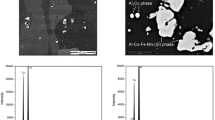Abstract
Entrained double oxide films have been held responsible for reductions in mechanical properties in aluminum casting alloys. However, their behavior in the liquid metal, once formed, has not been studied directly. It has been proposed that the atmosphere entrapped in the double oxide film defect will continue to react with the liquid metal surrounding it, perhaps leading to its elimination as a significant defect. A silicon-nitride rod with a hole in one end was plunged into liquid aluminum to hold a known volume of air in contact with the liquid metal at a constant temperature. The change in the air volume with time was recorded by real-time X-ray radiography to determine the reaction rates of the trapped atmosphere with the liquid aluminum, creating a model for the behavior of an entrained double oxide film defect. The results from this experiment showed that first oxygen, and then nitrogen, was consumed by the aluminum alloy, to form aluminum oxide and aluminum nitride, respectively. The effect of adding different elements to the liquid aluminum and the effect of different hydrogen contents were also studied.
Similar content being viewed by others
References
J. Campbell: Castings, 2nd ed., Butterworth-Heinemann, Oxford, U.K., 2003, pp. 17–69.
N.R. Green and J. Campbell: AFS Trans., 1994, vol. 114, pp. 341–47.
C. Nyahumwa, N.R. Green, and J. Campbell: J. Mech. Behav. Mater., 1998, vol. 9, pp. 227–35.
C. Nyahumwa, N.R. Green, and J. Campbell: Metall. Mater. Trans. A, 2000, vol. 31A, pp. 1–10.
C. Nyahumwa, N.R. Green, and J. Campbell: AFS Trans., 1998, vol. 58, pp. 215–23.
S.A. Impey, D.J. Stephenson, and J.R. Nicholls: Mater. Sci. Technol., 1988, vol. 4, pp. 1127–32.
S. Impey, D.J. Stephenson, and J.R. Nicholls: Microscopy of Oxidation, Proc. 2nd Int. Conf. Institute of Materials, Selwyn College, University of Cambridge, Cambridge, United Kingdom, March 29–31, 1993, pp. 323–37.
M.W. Chase: JANAF Thermochemical Tables, American Chemical Society and American Institute of Physics, National Bureau of Standards, MI, 1985.
Author information
Authors and Affiliations
Corresponding author
Additional information
This article is based on a presentation made in the John Campbell Symposium on Shape Casting, held during the TMS Annual Meeting, February 13–17, 2005, in San Francisco, CA.
Rights and permissions
About this article
Cite this article
Raiszadeh, R., Griffiths, W.D. A method to study the history of a double oxide film defect in liquid aluminum alloys. Metall Mater Trans B 37, 865–871 (2006). https://doi.org/10.1007/BF02735007
Issue Date:
DOI: https://doi.org/10.1007/BF02735007




